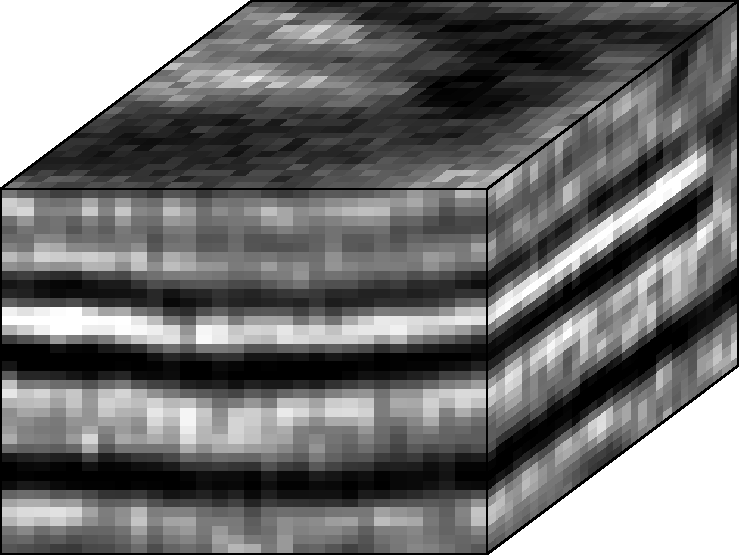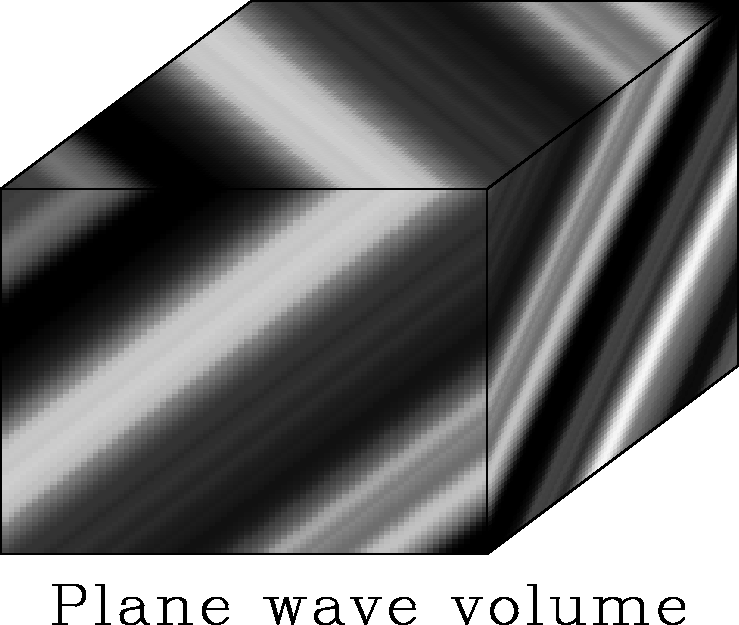|
nseaFoltZomRaw
Figure 2 Detail of a typical seismic image volume. The image of the sedimentary bedding approximates a nearly horizontal plane-wave volume. |  |
Sedimentary rocks, the standard environment of hydrocarbon reservoirs, are deposited in horizontal, parallel layers. Subsequent subsidence, uplifting or thrusting may displace or tilt a sedimentary rock package regionally; however, locally, the sedimentary rocks remain layered. Often sedimentary rocks even remain horizontal, albeit severely dipping beds are not uncommon. The detail of a seismic image volume in Figure 2 shows the typical layers of a seismic image of sedimentary rock packages. Figure 3 stylizes the layering in a dipping plane-wave volume.
|
nseaFoltZomRaw
Figure 2 Detail of a typical seismic image volume. The image of the sedimentary bedding approximates a nearly horizontal plane-wave volume. |  |
|
planWaveRaw
Figure 3 Synthetic plane-wave image volume. The plane-wave volume resembles undistorted sedimentary beds. |  |
In basins (the standard object of seismic images), faulting, intrusion, and erosion break the original sedimentary layers into smaller sedimentary packages and give rise to plane-wave discontinuities within the seismic image volume. Rocks of a volcanic intrusion, a turbidite flow, or a sedimentary salt give rise to discontinuities by placing their unbedded rocks next to the older sedimentary rocks. Erosion creates subsurface discontinuities by first removing parts of the original sediments and later replacing them with younger sediments. In this case, the discontinuity is due to the difference in the dip and sequence of layers of the old and young sediments. In particular, river channels wash old sediments away until it replaces them by younger layers of silt. Similarly, a discontinuity due to a fault does not separate fundamentally different rocks. Instead, a fault simply offsets and tilts the previously continuous sedimentary layers. A fault perfectly parallel to its surrounding sedimentary layers, or a fault that perfectly realigns a periodic layer package by a multiple period, would be locally invisible.
In a seismic image volume, a subsurface plane-wave discontinuity usually gives rise to a two-dimensional reflection surface, since in general the discontinuity is a boundary between rocks of different impedance. If the adjacent rocks are similar, as it is often the case with faults, the alignment of the original layers can cause reflections of variable amplitude along the discontinuity. Due to the spatial limits of a seismic survey, reflections from near-vertical discontinuities may not be recorded. Such discontinuities are only visible due to the contrast of the adjacent rock packages. For example, a fault without reflection is visible due to the misalignment of the adjacent sedimentary layer packages.
Additionally, shortcomings in the seismic experiment and processing can cause unwanted image discontinuities. Dead traces, acquisition footprints, unfocused diffractions, and large increments between time slices can result in discontinuities of the seismic image volume that are unrelated to the underlying geology. Image processing can cause otherwise sharp discontinuities to appear smooth. It can either fail to focus the discontinuities or simply smoothen it due to filtering.
In summary, I expect a discontinuity attribute to